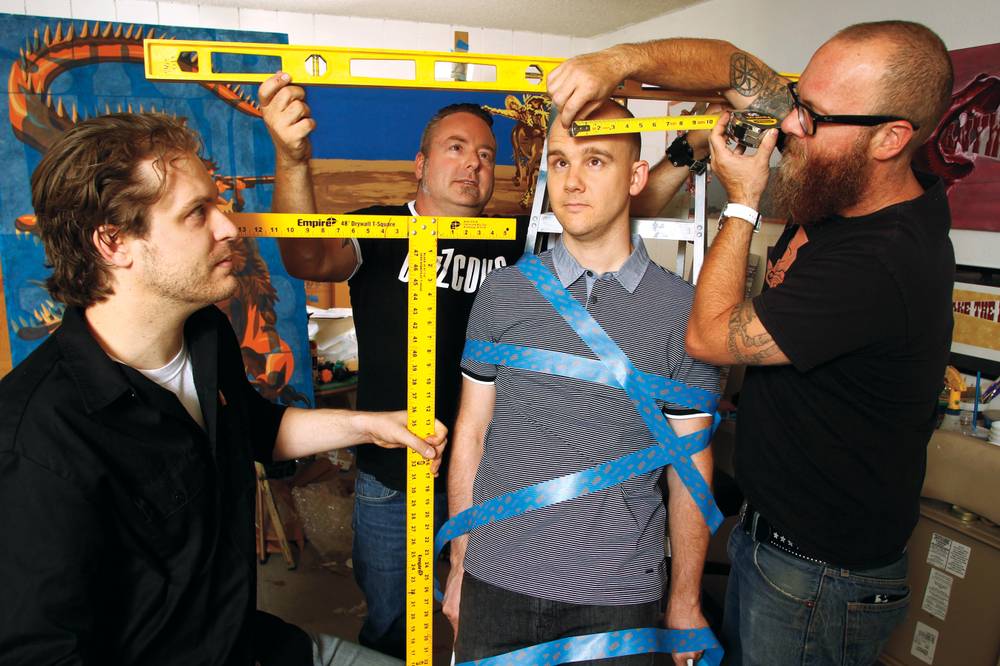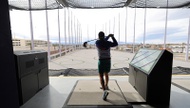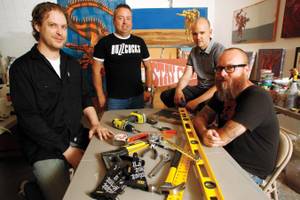Cleaning a Damien Hirst sculpture can be tricky, particularly when it’s from the artist’s series of dead animals floating in formaldehyde.
There’s the draining of the enormous tank and then the refilling with formalin. Even a minor spill can launch fumes into your eyes, nasal passage and throat, tossing you blindly out of the contamination room.
But this is art. Someone must tend to it. Someone with expertise. Someone passionate about the job. Someone willing to spend four hours hand-washing the dust and sticky car fumes off the Jenny Holzer installation in Aria’s valet. Someone who’ll knock down walls to get artworks into a gallery. Someone like JW Caldwell, who, after recounting the formalin incident, says of his fellow art handlers, “We are a species of monkey that lives in a specific tree. We eat art.”
Caldwell, an artist himself, is among a half-dozen or so handlers in town responsible for unpacking and installing works by Monet, Warhol, Stella, Basquiat, Picasso and any others that might come to Las Vegas for exhibitions, corporate collections or private ownership in Valley homes.
Though the Guggenheim Hermitage Museum, once housed in the Venetian, is gone, as is the Las Vegas Art Museum, there’s still the Bellagio Gallery of Fine Art, CityCenter’s $40 million art collection and other casinos displaying works. Then there are the vast corporate and private collections that the public never gets to see.
“There’s a ridiculous amount of art in this town,” says handler and artist Brent Sommerhauser, “between the corporate collections, which are enormous, and the art that every vice president and every CEO owns. There’s this level of money and access here. People will have an event and need art moved around or installed.”
And always, there are logistical issues when dealing with works that can weigh several hundred pounds or be hundreds of years old, are made from any material imaginable and are sculpted so delicately that just moving them from one room to the next can be risky.
But handlers, usually artists themselves who hold full-time jobs in art or other industries, are experienced professionals. When the call comes, they slip on special white cotton gloves and work in crews, bringing with them the knowledge from their own experience creating or moving art. Nondisclosure agreements prohibit handlers from talking about specific works and collectors, but the job gives them a rare kind of access.
“I love art,” Sommerhauser says. “You can go to a gallery and look at art. Or you can know how heavy it is, what it smells like and what methods were used to frame it.”
You can even wrestle with it, if only psychologically.
“It’s just a huge game of how do you fit this square peg into this round hole, and how do you get it out, because inevitably the lender wants it back or the collector wants it moved,” Caldwell says. “It’s frustrating when it’s [small]; it’s terrifying when it’s 20 feet long.
“We get asked to do the impossible,” Caldwell says. “We’ve had to crane works onto balconies to get them in a house and crane works over houses to get them into yards.”
But, he adds, “Part of the reason I enjoy this job is that I get to see everything in this town.”
Caldwell, head preparator for MCQ Fine Art, has found himself in some precarious situations, acquiring knowledge and skills the rest of us might never consider. He knows how to knock down and replace walls in high-end galleries on the Strip for art that can’t fit through the door, and that a 19th-century masterpiece can’t be rolled across cobblestone because the paint will rattle off, no matter how well it’s crated.
It’s invaluable to the job, says Sommerhauser: “We’re moving incredibly heavy, delicate objects in environments that they’re not supposed to be in. It’s this deliberate and slow process. They’re taking the art out of a perfectly safe environment, putting it in harm’s way for 72 hours.”
The Guggenheim Hermitage brought in works by Peter Paul Rubens, a baroque painter who died in 1640, making all of his work at least 300 years old. The Bellagio Gallery has shown work from the Museum of Fine Arts, Boston and Museum of Contemporary Art San Diego. Its current Warhol Out West exhibit features works from the Andy Warhol Museum in Pittsburgh.
“Part of our job is to know what’s good or bad for artwork,” says handler Shawn Hummel, who was project manager of art services and preparations at the Guggenheim Hermitage during its day and now works on crews for other projects as well as running his own art-handling company.
“There are a lot of challenges with having valuable and fragile art in Las Vegas in a casino,” he says. “People come here to lose their minds. At the Guggenheim Hermitage, the loading and unloading was done after midnight and before 6 a.m. by the valet. Coincidentally, that’s when the valet is most out of control with the highest percentage of drunks.”
But Hummel and the others say they prepare themselves for anything because, in fact, just about anything might come their way. Often, they walk through the installation process well before handling the works. Expertise is celebrated. If there’s potential for electrocution, Sommerhauser—who’s been struck by lightning, electrocuted and lightly zapped while working odd jobs or on art projects—can, according to the others, “handle it.”
“It might be assumed that I’m more careful in light of knowing what could happen,” Sommerhauser says, after detailing his lightning strike at age 10 and electrocution later in life. (He was saved only by the copper bracelet he happened to be wearing.)
While Hummel and Sommerhauser are the “carpenter geeks” of the group, Caldwell has built scale models for the Las Vegas Art Museum and Bellagio Gallery of Fine Art. Then there’s RC Wonderly, who freelances on the crews, helps strategize and is now creating computer models of the galleries using Google SketchUp.
“It’s a lot of problem solving,” says Wonderly, exhibitions and collections manager at the Bellagio, where, among other tasks, he inflates the Warhol balloons at the Warhol exhibit every morning. “We all have our own styles. There are little nuances, even as simple as how we each grab a piece.”
Wonderly says that art handling influences his own work just by studying the mechanics of how another artist might have approached his piece in terms of size, construction and dimension.
“We’ll geek out,” Wonderly says. “If it’s a certain piece or someone likes that artist, we’ll try to get them on the crew.”
So long as they have the qualifications, Caldwell says.
“You spend your life going to museums and you’re told, ‘Don’t touch it; don’t touch it; don’t touch it.’ Now, you’re the only one who can touch it. If you f*ck up, it only takes once and you’re done.
“You’re dealing with irreplaceable moments of history,” Caldwell says. “If we do our job properly, it looks like it was genie-wished onto the wall.”









Previous Discussion: